Dee Estuary Birding
Monthly Newsletter...
September 2025
Newsletter
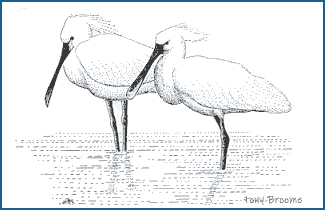
Hoylake Shore - 25 Year Highlights
Reading Jane Turner's fascinating article in the August edition of Birdwatch magazine (A life of county listing: Cheshire) got me thinking just what a great birding site Hoylake shore is. We've had some great rarities over the past few years, some amazing sea-watching during autumn gales and huge flocks of waders and sea-birds, and much else besides. September is always a particularly good month so I thought it would be appropiate, in this September Newsletter, to list the highlights of what's been seen at Hoylake going back to the beginning of this century. I've put the list in the latest taxonomic order according to BOU, and I've included comments in order to give the records some context. I've also put links to relevant articles from previous newsletters:
Surf Scoters March 2015
March 2015 saw large numbers of Common Scoters
feeding close in to East Hoyle Bank. Local birders made the long walk
out there from Hoylake at low tide several times that month but it
wasn't until the
25th that Allan Conlin and Kenny Dummigan at last spotted Cheshire and
Wirral's first Surf Scoter. Over the following 10 days many other
birders
also made the trek out there and a remarkable total of nine different
Surf Scoters were recorded. (How
Many Scoters!!?? May 2015)
Common Scoters
October 2016
On a flat calm sea on October 21st an amazing 40,000
Common Scoters were counted off Hoylake. The previous record for
Cheshire and Wirral was 27,000 counted in 2014, in 2016 that record was
broken no less than four times.
Black Scoter March
2025
An exellent find by Sean O'Hara who spotted this mega rarity among the throng on March 5th. Last seen on March 19th and another first for Cheshire and Wirral.
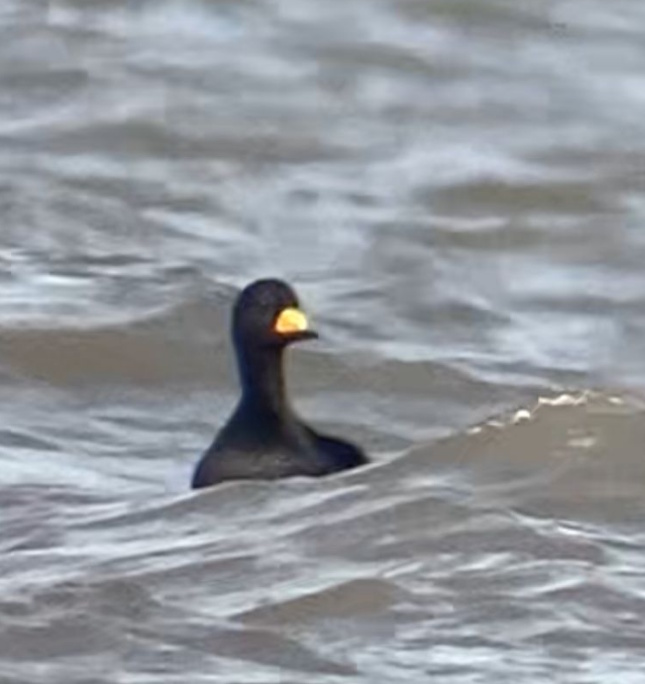
Pallid Swifts
October 2022
Part of an unprecedented influx of Pallid Swifts
into the country included one over Hoylake on October 27th, with a
second on October 31st. The first for Cheshire and Wirral.
Great Crested Grebes
January 2011
From 2006 onwards we started to see several hundred
Great Crested Grebes along north Wirral, over-wintering. The highest of
those counts was made off Hoylake on a flat calm sea on January 20th
2011 with 1195, only Dungeness and Rye Bay had a bigger count in the UK
that winter. (Great
Crested Grebes off North Wirral December 2010).
Grey Plovers March
2013
Winter peak numbers are usually around 1,000 for
Grey Plover so to get 4,000 on March 2nd 2013 was an impressive number.
The count was made during a RSPB High Tide Birdwatch with loads of
other waders present too, which made it even better!
American Golden
Plover August 2021
A first year bird was on Hoylake beach on August 7th
and 8th, what was assumed to be the same bird was on Frodsham Marsh a
week later. This is the sixth record for Cheshire and Wirral including
two at Leasowe and one over Hilbre.
Knots December 2001
The highest ever WeBS (Wetland Bird Survey) count of
Knots on the Dee Estuary was 52,000 on Hoylake Shore on December 16th
2001. I remember ringing up the North Wirral WeBS coordinator,
Carl Clee, that evening with my own count (inland fields) and him
telling me about this massive count. Carl, who was one of the most
experienced wader counters in the country, wasn't supposed to be at
Hoylake that day as he was counting elsewhere, but he'd been asked to
get down to Hoylake ASAP as the counter who was there couldn't believe
the numbers he was getting and wanted Carl to help him!
I wasn't at Hoylake that day but there were three
memorable days in January 2013 which I did witness which I want to
share with you.The winter of 2012/13 was a particularly good one for
Knots on the Dee Estuary and North Wirral, the highest count at Hoylake
that winter was 37,000 in November and I had a low tide count of 48,000
at Thurstaston in January, but it was these three days which have stuck
in my memory, and I quote from the February 2013 Newsletter:
Saturday January 12th was
the day of the High
Tide Birdwatch at Hoylake
and it was an outstanding day with at least
200 birders enjoying the spectacle of 25,000 waders pushed in by a big
high tide which included 1,200 Sanderling - one of the highest ever
January counts for this species on the Dee Estuary. If Saturday was
outstanding then Sunday was even better with the higher tide pushing
the birds that much closer, for about 30 minutes half the Knot flock
aerial roosted overhead which was an amazing sight in itself. Then came
Monday which was simply astonishing, the birds were so close to the end
of King's Gap you could almost touch them, unlike the previous day the
birds stayed mainly on the sand and were surging backwards and forwards
like breaking waves. (Knots
on the Dee Estuary 2012/13 - October 2013).
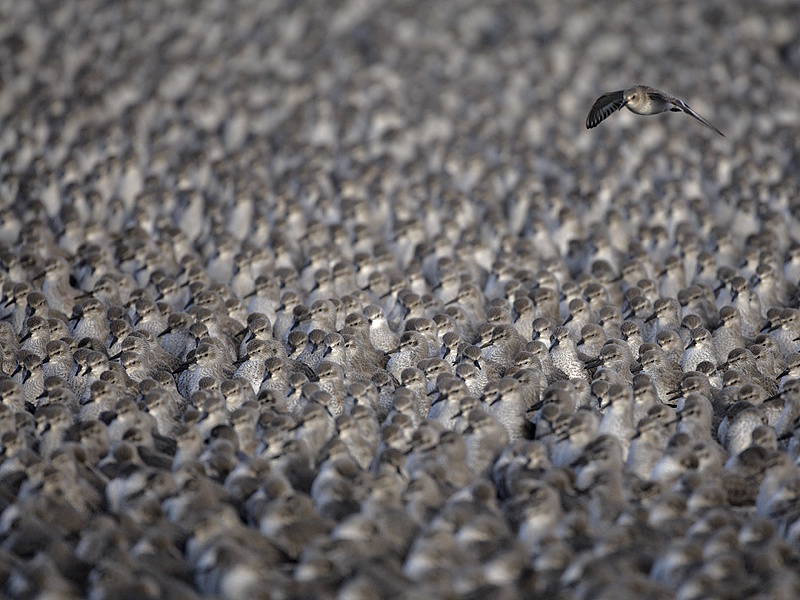
This photo was taken on Jan 14th (Monday) 2013, this is a sight commonly seen at Snettisham in the autumn but very unusual at Hoylake. We do get large numbers of Knots at Hoylake but usually they are out on the sand bank, standing on one leg and roosting. Steve took this photo from the promenade where we were all standing with the knots just a few feet away showing no sign that they wanted to take flight but constantly moving around. It was exraordinary!
Broad-billed Sandpiper
May 2011
A Broad-billed Sandpiper was spotted among several
thousand Dunlins on May 15th, and was last seen on the 20th. This was
the fifth record for Cheshire and Wirral.
Curlew Sandpipers August
and September 2000
There's been some good passages of Curlew Sandpipers
at Hoylake over the past 25 years but the largest flock was 30 counted
on three dates - August 29th and 30th, and September 2nd 2000. 2011 was
also a good year with 24 on September 5th. (The
Curlew SandpiperInflux - November 2011)
Sanderlings
November 2012
I've already mentiioned that the winter of 2012/13
was good for Knots and Grey Plovers, and it was also good for
Sanderlings with a count of 1900 at Hoylake in November 2012. The WeBS
count for the whole of the Dee Estuary was 2158 for that November and
that remains the highest WeBS count since the mid-1970s. (Species
Spotlight - Sanderling February 2025).
Baird's Sandpiper September 2023
A juvenile was spotted at Hoylake on the 20th, and was subsequently recorded the next day at both Hoylake and Meols. Three previous records for Cheshire and Wirral have all been at the Weaver Bend, Frodsham. I'm not sure if this has yet been accepted by the BBRC but it was in the 2023 Cheshire and Wirral Bird Report so qualifies for this list.
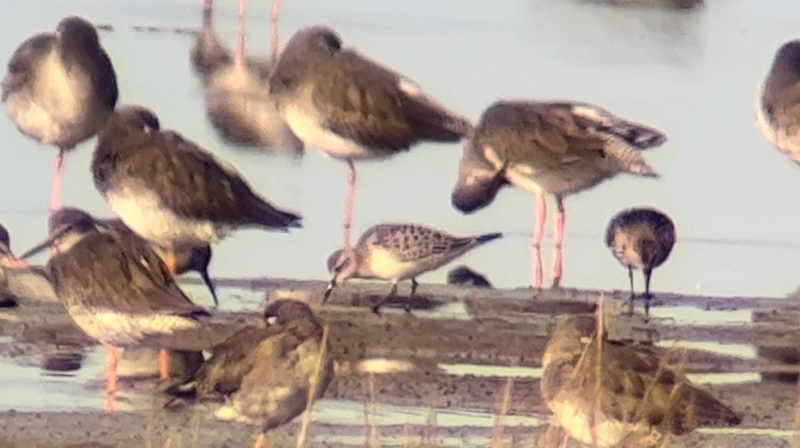
Little Stints
September 2000
Two or three Little Stints are regular on Hoylake
shore during the return migration, but 15 on September 15th 2000 were
exceptional. (Species
spotlight - Little Stint September 2024)
White-Rumped Sandpipers September 2000
Singles were at Hoylake on September 2nd, 4th and
from 9th to 13th 2000, it seems probable two birds were involved.
Singles were also present on August 31st 2011 and September 21st 2012.
Western Sandpiper September 2012
A Western Sandpiper was with Dunlin on Hoylake Shore between September 19th and 24th. There was much debate about the ID of this bird, and it was with BBRC for four years before they eventually agreed with the finder, Allan Conlin, that it was a Westerm Sandpiper. A first for Cheshire and Wirral, and ninth record for the UK.
Semipalmated Sandpiper September 2013
Exactly a year after the Western Sandpiper was seen another American 'peep' turned up, this time a Semipalmated Sandpiper, seen on September 21st 2013. A second record for Cheshire and Wirral.
Black Terns September 2006
We usually get one or two Black Terns turning up at
Hoylake over the autumn migration, but an influx into the country on
September 13th 2006 resulted in a flock of 40 to 50 flying west.
White-winged
Black-tern July 2003
One was on Hoylake shore on July 13th 2003 having
earlier been recorded at Hilbre on the 9th. This was the 15th record
for Cheshire and Wirral.
Sabine's Gull
September 2004
During September gales we sometimes see one or two
Sabine's Gulls, more likely than not juveniles, but on September 21st
2004 there were definitely four off Hoylake (three juvs and an adult)
and quite possibly as many as nine. (Sabine's
Gull - September 2020).
Bonaparte's Gull
August 2018
An adult was at Hoylake on August 12th 2018 and was
regularly seen until the 18th, also reorded from Hilbre on several
dates. This was the seventh record for Cheshire and Wirral. (Bonaparte's
Gull - September 2018)
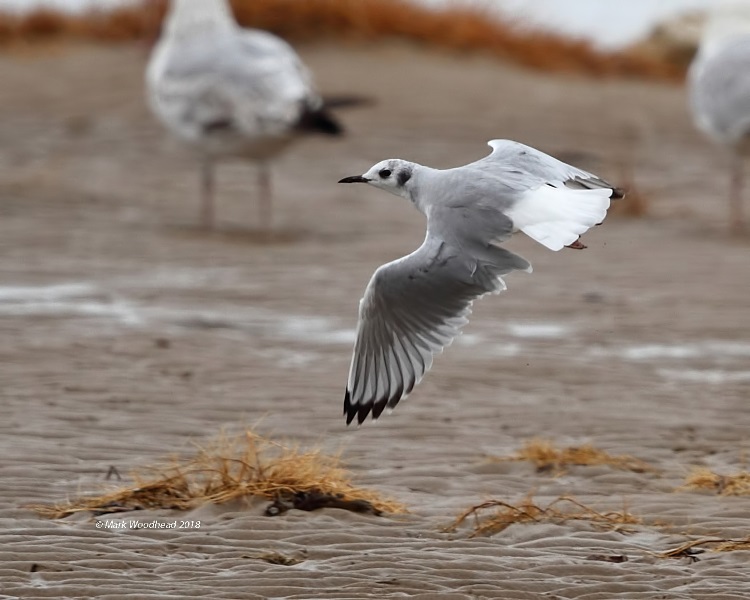
Great Black-backed Gulls October 2003
The gull roost on Hoylake shore is more or less a
permanent feature all year round. and there are nearly always some
great big brutes among them - Great Black-backed Gulls! Numbers usually
peak in autumn with typically 60 or so, but there were 150 present on
October 9th 2003. More recenly there was a good count of 100 on
September 30th 2023.
Herring Gulls February 2013
The first three months of 2013 saw some very high numbers of Herring Gulls along north Wirral, particularly in February. There were counts of 20,000 at Hilbre and 16,000 at Leasowe but the highest count at Hoylake was 14,500 on February 14th 2013.
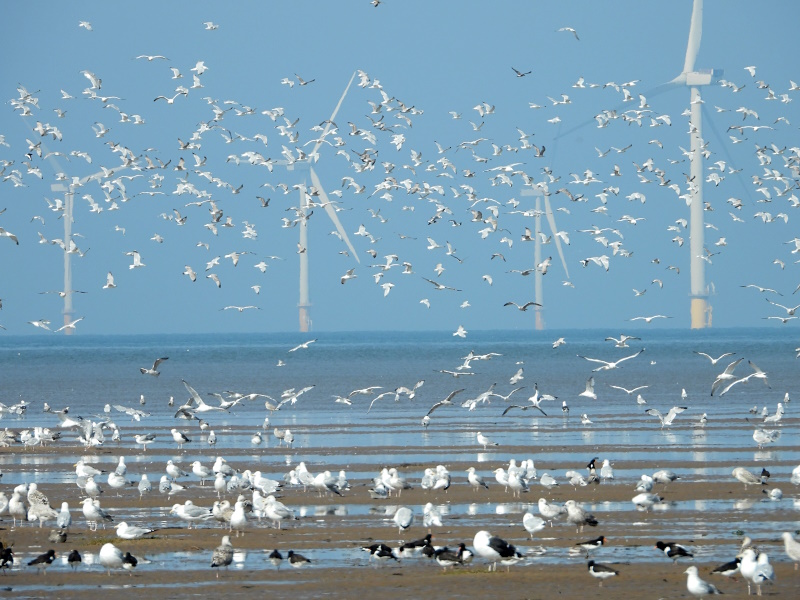
In 2013 it was like this all the way from Hilbre to New Brighton!
Arctic Skuas September 2010
Prolonged north-westerly gales mid-month resulted in
some fabulous sea-watching including a count of 70 Arctic Skuas off
Hoylake on September 14th 2010. More recently 62 on September 4th 2019
was a good high count. (Arctic
and Great Skuas - September 2019)
Pomarine Skuas October
2006
Pomarine Skuas are not quite annual off Hoylake
although most years one or two are recorded. A flock of five flying
west was a nice surprise on October 4th 2006. (Pomarine
and Long-tailed Skuas - October 2019)
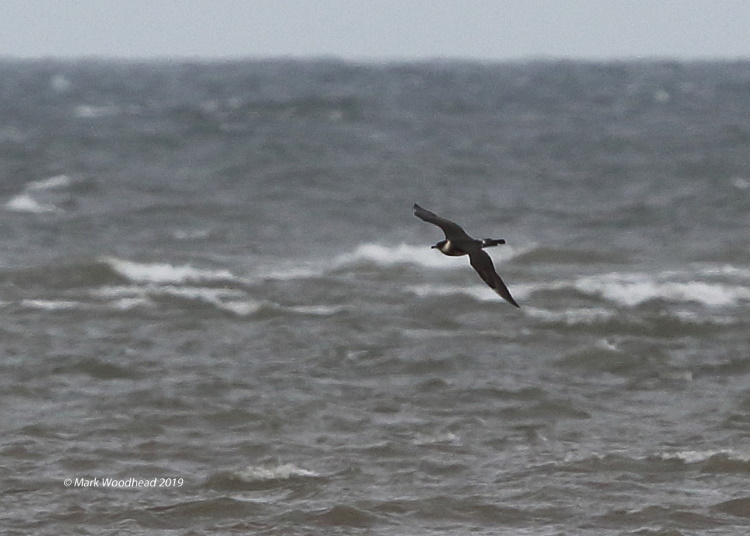
Great Skuas September 2004
Great Skuas are regular off Hoylake, particularly
during strong winds, but more often than not just in single figures.
But prolonged NW winds brought in big numbers in 2004 with the highest
count being 38 on September 21st. (Arctic
and Great Skuas - September 2019).
Red-throated Divers
March 2020
One of the species for which the Liverpool Bay SPA
has been designated is the Red-throated Diver, in 2017 it was reckoned
to hold almost 7% of the UK's wintering population or about 1,170
birds. Red-throated Divers are regular off Hoylake but there needs to
be a flat calm and good seeing conditions for good numbers to be
recorded, March 1st 2020 saw just those conditions when at least 60
were counted.
Leach's Petrels September 2010
September 2010 was exceptional for Leach's Petrels
with max count of 205 flying past Hoylake on September 17th during some
prolonged
north-west gales. We normally don't see any Leach's Petrels in December
but south-west gales in early December 2006 blew in an unexpected 68 on
December 9th. (Leach's Petrel 2010 October 2010).
Sooty Shearwaters September 2000, 2010 and 2013
A rare visitor this far into the Irish Sea but we had singles on September 6th 2000, September 14th and 15th 2010 and September 19th 2012, the latter being close into Hoylake beach.
Manx Shearwaters June 2013
Regularly seen off Hoylake in the breeding season, particularly during strong west winds. Max counts are usually in double figures but occasionally much higher numbers are recorded such as 3,785 on June 23rd 2013 during a gale, over 5,000 were counted off Hilbre on the same day.
Balearic Shearwaters October 2003
There are 12 records for Cheshire and Wirral, mainly
of birds recorded from Hilbre and Red Rocks, but two were off Hoylake
in 2003 with singles on October 4th and 6th.
Barolo Shearwater September 2010
One was recorded at both Meols and Holyake on
September 14th 2010. It took until 2022 before BBRC accepted it, this
was not so much a problem with that particular sighting but rather
because of a review of all 'Little Shearwater' records going back to
2000 which took a long time to finalise. (Barolo
Shearwater - December 2023)
Gannets August 2013
Most days from April to September will see some
Gannets off Hoylake, usually flying steadily east to west along the
coast but occasionally large feeding flocks are seen circling over the
sea with many birds diving for fish. Max counts are usually in three
figures but the max August count in 2013 was 1,000 (undated monthly
max).
White Wagtails April 2011
We see White Wagtails every April flying between the
continent and Iceland, and it always amazes me that such delicate
looking birds attempt to fly across the Atlantic. Many migrate along
the coast and they often stop to feed on sand flies on Hoylake beach.
It's easy to miss them scattered as they are over a wide area of sand.
It isn't until you get your 'scope out and start counting do you
realise just how many there are but April 9th 2011 was exceptional with
at least 500 between Red Rocks and Hoylake.
Snow Buntings January 2021
Stunning looking birds which are annual along north
Wirral, although usually just two or three these days but they used to
be far more numerous. Late December 2020 saw the arrival of eight which
stayed for most of January in the new marsh on Hoylake shore, these
gave much pleasure to both birders and the general public. (Snow
Bunting February 2021)
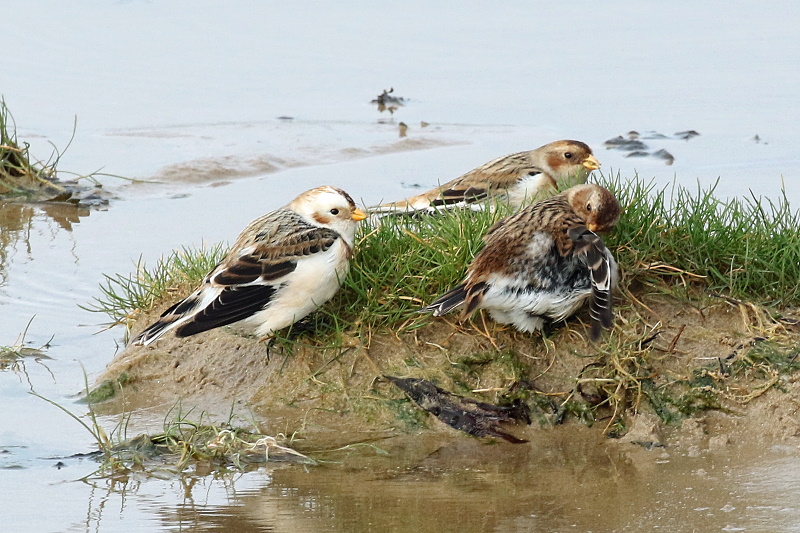
So that's 34 species in total ranging from mega
rarities which are firsts for the county, to species present in tens of
thousands, and from species which are present all year round to those
we only ever see on a few days each year on migration. All great to see.
Sources of information:
Apart from my own records and those from this website (www.deeestuary.co.uk), I have used the following sources:
1. Cheshire and wirral Bird Reports (2000 to 2023), published by CAWOS.
2. Allan Conlin & Eddie Williams, Rare and
Scarce Birds of Cheshire & Wirral, 2017.
Richard Smith
Colour Ring Report
Ringed Plover
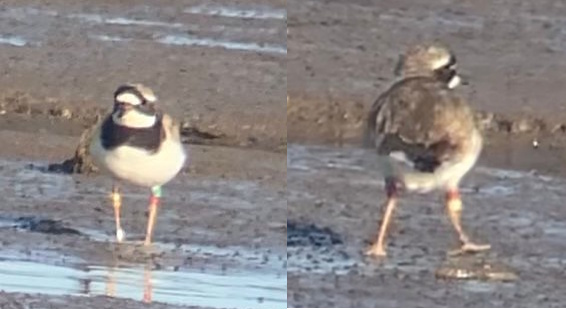
GR - RY
Ringed at Bubsque Island, Bijagos Archipelago, Guinea-Bissau on
03/02/2018.
It was recorded at the ringing site twice more in February 2018 and
also in November 2018 and April 2019.
Seen and photograped on Meols shore on 26/08/2025.
What a great find by Sean O'Hara! According to the BTO website this is the first ringed Ringed Plover from Guinea-Bissau to be recorded in the UK.
Guinea-Bissau is the country just to the south of
Senegal (and c100km south of Gambia) in West Africa, and the Bijagos
Archipelago is just off the coast. The islands are hugely important for
over-wintering waders and hold up to a massive 800,000. I was intrigued
to read about the very large numbers of Curlew Sandpipers there
(typically 300,000), also there are about 100,000 Bar-tailed
Godwits present. Ringed Plover numbers are around 20,000 to 30,000 (Click here to download an article about the birds of
the islands - pdf).
Black-tailed Godwits
We saw 21 different colour ringed Black-tailed
Godwits during August, with a total of 96
records. We are still waiting for feedback for a few but here are
details of a couple of interesting ones.
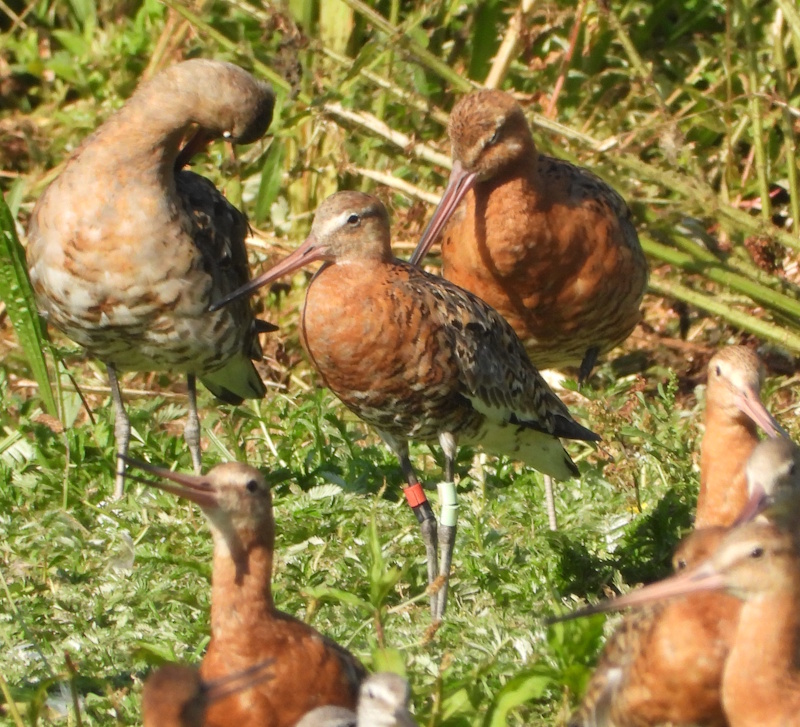
LL-RN
Ringed, as a chick, in Iceland in June 2013, LLRN has been sighted
numerous times over the full range of the islandica sub-species. The map
below illustrates its movements.
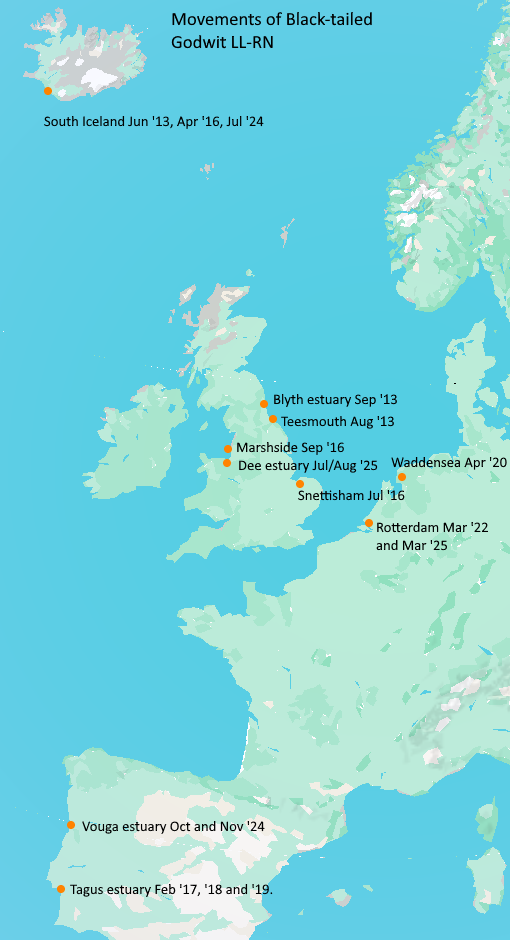
To summarise, after breeding in Iceland it undergoes
summer/autumn moult either on the west or east coast of the UK, in 2016
it visited both coasts.
It spends each winter in the rice fields of Portugal before flying
north-east to the Netherlands in March and April, and then flying back
to Iceland. All this is typical for birds that winter in Portugal, but
it's unusual that we get so much detail thanks to the volounteers who
go out colour ring spotting - like us!
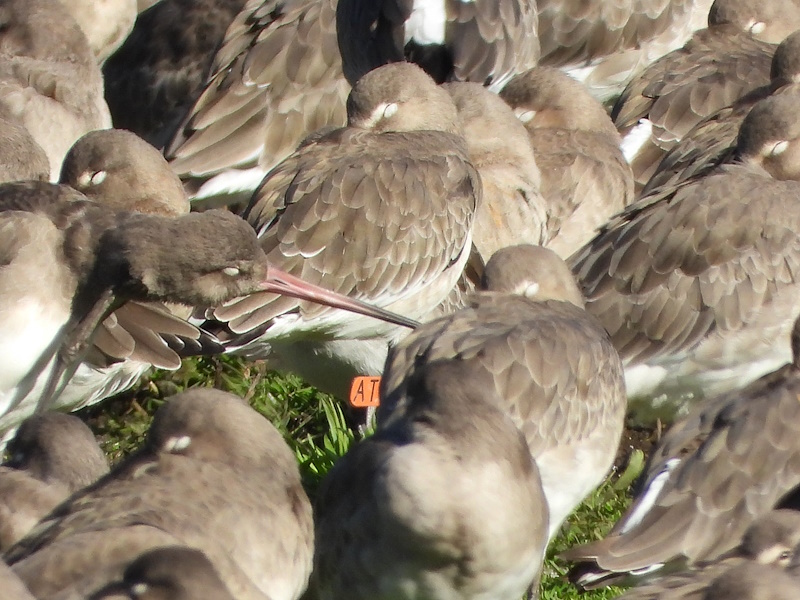
Oflag (AT)
Ringed at Bangor Harbour on 28/01/2024
It spent the following summer and autumn first at Burton then at Caldy
before spending the winter (2024/25) in North Wales, being recorded at
Llanfairfechan in December, February and March.
This year, on it's return from breeding in Iceland, it unexpectedly
turned up in South Wales, at the Loughor Estuary near Llanelli. It
was there from mid-July to early August 2025, before making it's way
north
to Caldy where it was recorded on 24/08/2025.
I find it intriguing when birds make unexpected
movements like this. I wonder what route it took from Llanelli when
flying back to the Dee estuary? Maybe it flew up the Severn estuary and
past Slimbridge (where we know blackwits are regular), or maybe along
the coast, perhaps stopping off at the Dyfi estuary, or did it just go
directtly north and over the mountains!?
Knot
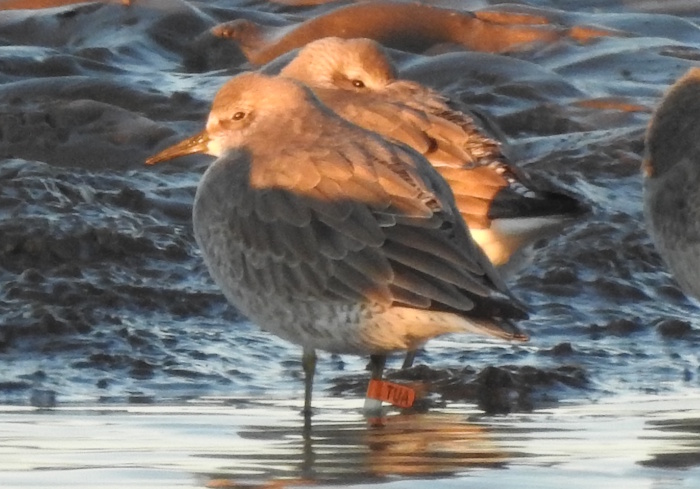
Orange flag (TUA)
over Pale blue.
Ringed at Ynyslas, Dyfi estuary, in September 2022 as a first year.
It was at Thurstston in January 2023 then showed some interesting
movements between Formby and Connah's Quay in April 2023 before being
recorded back at Connah's Quay in June and July 2023 as a non-breeding
2CY bird.
It was back at Thurstaston in the winter of 2023/24 before being seen
at Formby in April 2024. There are no further sightings until it turned
up again at Connah's Quay on 24/08/2025.
Barnacle Geese
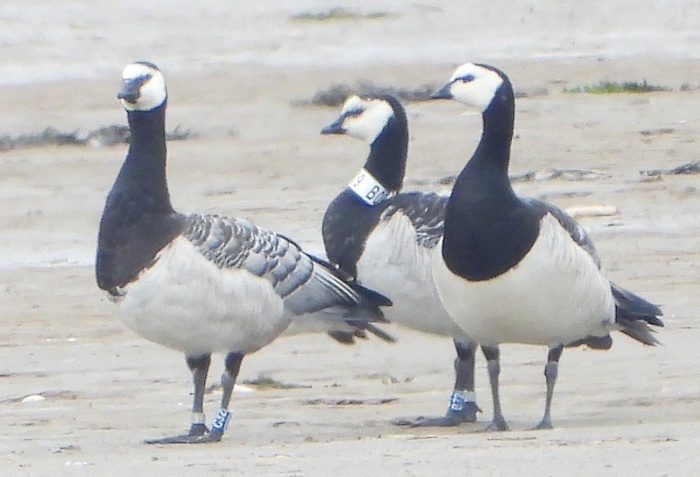
Blue (C32) and neck
collar White (B09) which also has blue ring (B72)
Both these were ringed at Sandwick, Ullswater in July 2021.
They have been seen several times since at both Ullswater and
Derwentwater, B09/B72 has also been recorded at Ynshir, Dyfi estuary,
in September 2022. Note that the neck collar was fitted in a subsequent
re-catch in 2022.
Recorded on Hoylake shore 23/08/2025.
With a naturalised flock of Barnacle Geese of at
least 30 in north Wirral they are hardly rare here, but none of us can
remember any ever being on the shore at Hoylake before. It was Allan
Conlin who found them and then realised one had a neck collar, and
subsquently we realised two of them also had blue rings. So these were
not part of the local flock, and the ringing history tells us they are
part of the flock which migrate 230 km from Ullswater/Derwentwater,
where they breed, to spend the winter on the Dyfi estuary in mid-Wales.
A small flock of Greenland White-fronted Geese spend each
winter on the Dyfi estuary so when Barnacle Geese started to join them
in the 1990s
it was assumed that they too were wild birds breeding in Greenland. But
colour ringing, started 10 years ago, confirmed that they were in fact
of naturalised origin and that they bred in the Lake District.
Incidently, because ring reading on the Dyfi was proving to be very
difficult they started fitting the much larger neck collars in 2022 and
the ease of reading them was confimed at Hoylake where Allan was able
to read the characters on 'B09' from a good distance away, I had to get
far
closer before I could get a decent photo of the rings.
Sandwich Terns
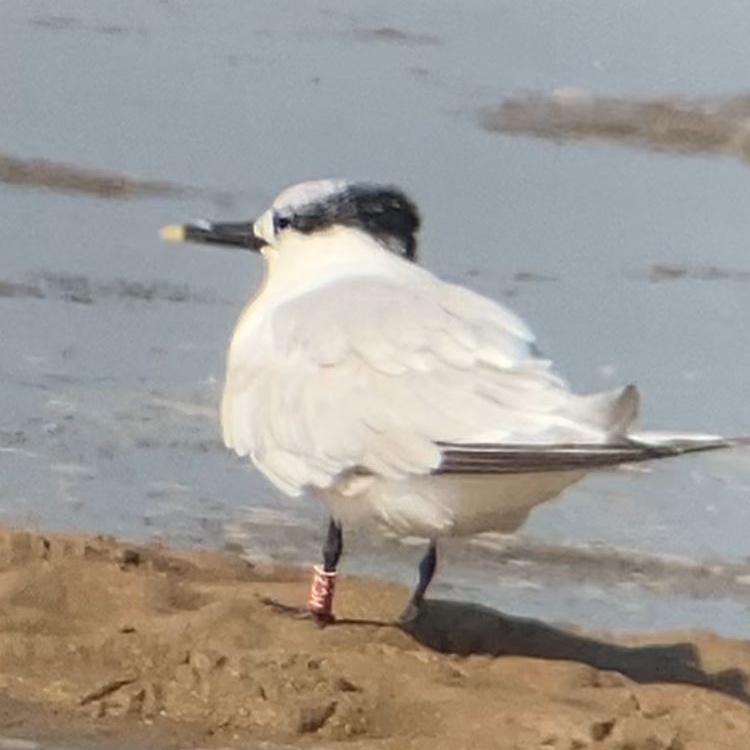
Red (HC2)
Ringed in Zeebrugge Harbour, Belgium, in May 2024, as an adult.
It was still at the ringing site in June before moving north to
Camperduin, Netherlands, in July 2024. In August it crossed the North
Sea and was spotted at Kilnsea Wetlands, Spurn.
April 2025 saw it on the northern French coast before it returned to
Zeebrugge in June.
It was recorded at Hoylake on 13/08/2025.
This is the first Sandwich Tern we've seen which has been ringed in Belguim.
Yellow (E51)
Ringed in June 2025 at Forvie NNR, Ythan estuary, NE Scotland, as a
chick.
Recorded at Hoylake on 25/08/2025.
After a tough couple of years with 'Bird Flu' (HPAI)
the Sandwich Terns at Forvie had a record breaking year in 2025 with
1,010 clutches and a large numbers of fleglings produced. I have heard
that the colony at Cemlyn Bay (Anglesey) also had a good season and as
did several other colonies, including RSPB Minsmere. Hopefully all
this means that the Sandwich Terns are making a good recovery from the
disaster that was Bird flu.
Shelducks
During August Shelducks started
returning to Thurstaston after their summer moult with many in the
stream which runs out from Tinkers Dell. They have been busy ringing
Shelducks at both Lower Derwent Valley NNR, Yorkshire, where they
ringed over 120 last winter, and at Seal Sands, Tees Estuary, and we
have recorded birds from both locations, including these two below:
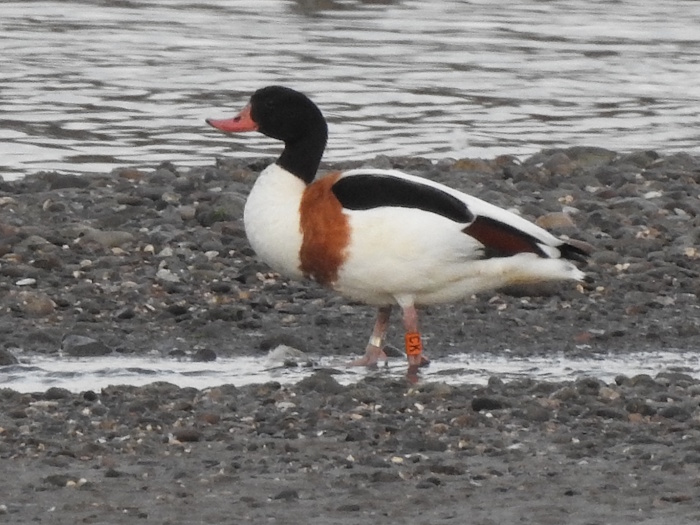
Orange (CK)
Ringed at Seal Sands, Tees estuary, on 12/04/2025 as a second year male.
Recorded at Thurstaston on August 26th and 28th 2025.
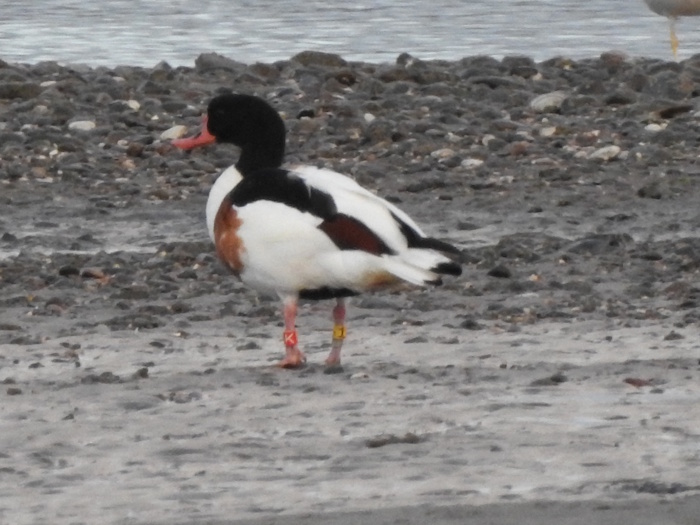
Red (K) Yellow (1)
Ringed at Bank Island, Derwent Valley NNR, Yorkshire, on 29/11/2024 as
an adult male.
Recorded at Thurstaston on 29/08/2025.
The ringer said "we collected a feather sample from this one for isotope analysis in the hope of identifying its moulting site and where it grew its feathers in summer 2024. So a really helpful resighting to help compare with the analysis."
Little Egret
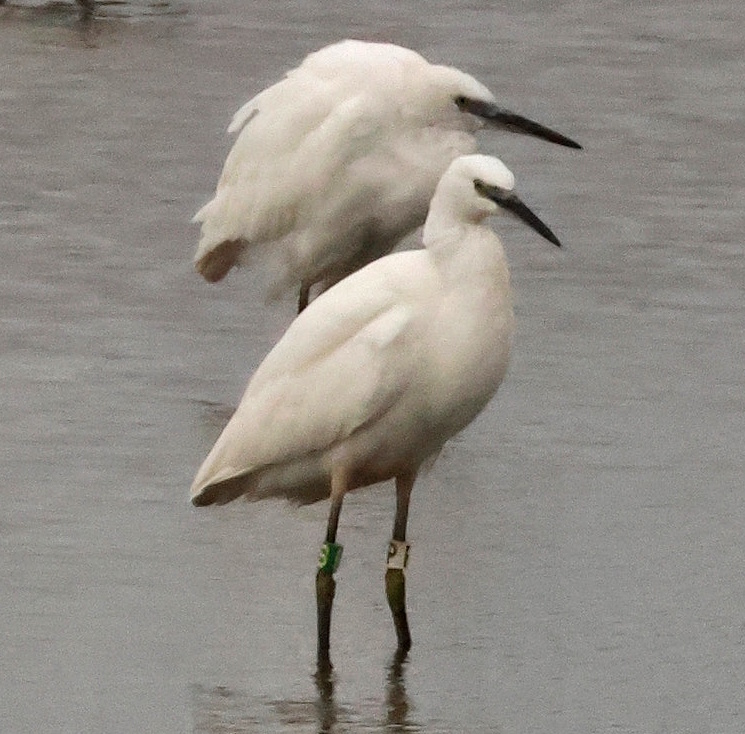
White (P) Green (B)
Ringed at Hale Duck Decoy on 29/05/2025 as a chick.
Recorded at Parkgate on 21/08/2025.
This was the first of this year's crop of colour
ringed Little Egrets to arrive from Hale.
Black-headed Gull
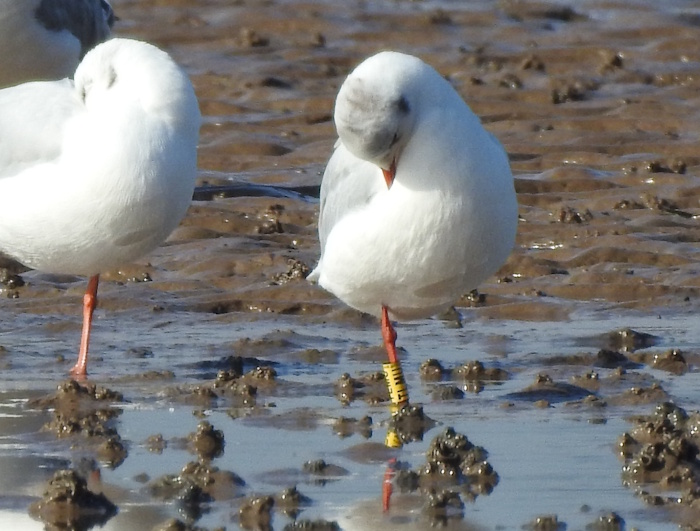
Ringed on the River Vistula, Wykowo (just west of
Warsaw) in June 2020, as a chick.
Recorded at West Kirby in June 2023, and at Thurstaston in October 2023
and 21/08/2025.
Rock Pipit
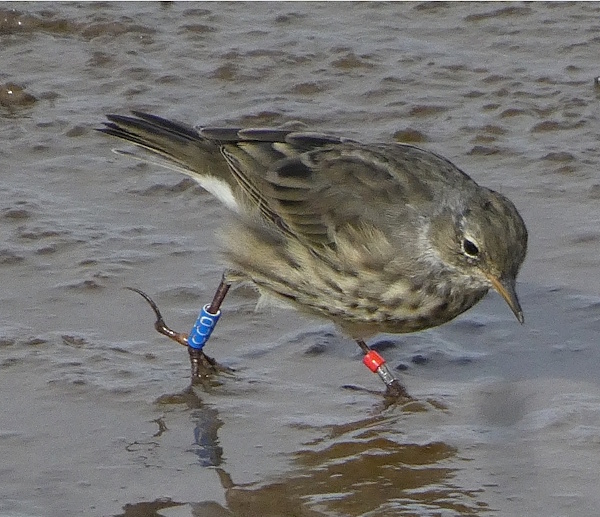
Hilbre Bird Observatory have been busy ringing more
Rock Pipits including this one Blue
(CCD),
ringed on Hilbre on 16/08/2025 and recorded at Meols on 29/08/2025.
Colour Rings were recorded by Richard
Smith, Stephen
Hinde, Richard Speechley, Alan Hitchmough, Allan Conlin, Sean
O'Hara, Helen Jones, Tony Ormond, John Kane, Graham Connolly, Richard
du Feu and Mike Pollard.
Richard Smith
August Bird News
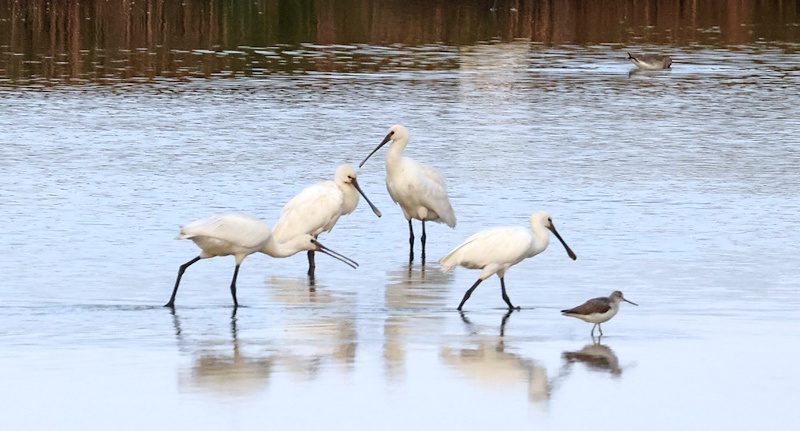
There were good numbers of birds at Parkgate throughout the month
giving great views from the prom, peak numbers were 26 Avocets (6th),
30 Greenshanks and 14 Spoonbills (both on the 26th), and also on the
26th a
Glossy Ibis was a nice rarity. There were good views of several Water
Rails,
including a young chick, a couple of Spotted Redshanks and several
Ruffs as well as a flock of Black-tailed Godwits.
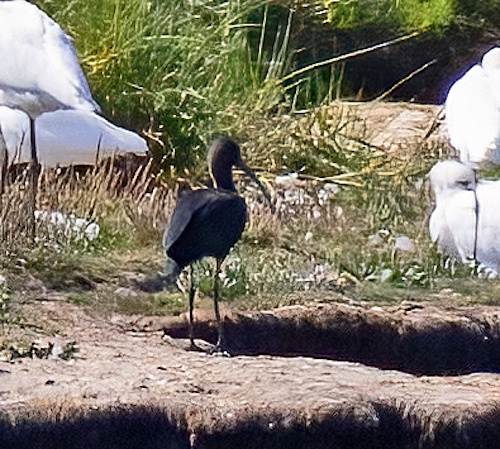
There was a good passage of Ruffs at
Burton Mere Wetlands, peak was 41 on the 22nd. A Bittern chose to fly
past the Visitor Centre several
times giving great views, and Marsh Harriers were much in evidence.
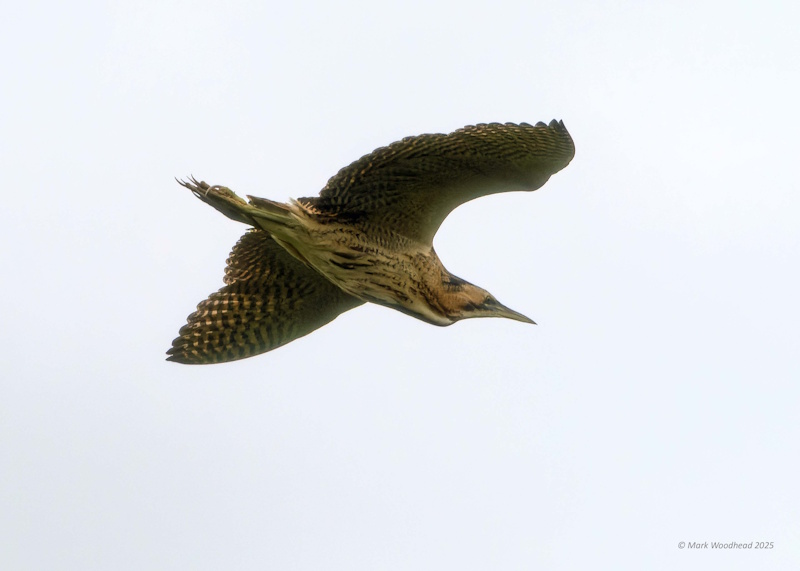
Storm Floris struck on the 4th and 5th but, as
far as seabirds were concerned, was a big disappointment with just one
Storm Petrel recorded in the River Mersey mouth. But it did blow in a
record number of Black-tailed Godwits taking shelter in the field at
Caldy
Wildfowl Collection with a massive 6,640 on the 5th. Other waders
included a max count of 5100 Redshanks at Heswall on the 22nd, one or
two Little Stints have been spotted - both at Meols/Hoylake and at
Burton Mere Wetlands, and there were three Green Sandpipers at the
latter site on the 19th.
Two early returning Short-eared Owls on
the marsh off Heswall Golf course on the 28th gave good views in the
evening, lets hope they stay for
the winter.
What to expect in September
You've only got to look at the article above, detailing highlights of
Hoylake Shore, to see how good September can be. We've had some good
Curlew Sandpiper passages over the past few years but last September's
was virtually non-existent - so lets hope they come back this year.
What we really want, more than anything else, are prolonged north-west
gales around mid-month which will bring loads of Leach's Petrels as
well as skuas, Grey Phalaropes, Sabine's Gulls etc.
Geese will be arriving back, we would expect the first Pink-footed Geese to arrive around mid-month and by the month-end thousands will be here. We will see the first Brent Geese around Hilbre, last year they had already reached well over 100 by the end of the month.
One or two Pectoral Sandpipers would be expected at
Burton Mere Wetlands and we expect an influx of Cattle Egrets and
Spoonbills.
September Highest
Tides:
9th 12.57hrs (BST) 9.6m
10th 13.34hrs (BST) 9.6m
11th 14.13hrs (BST) 9.5m